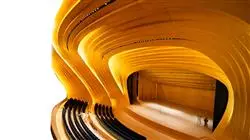University certificate
The world's largest faculty of engineering”
Introduction to the Program
Thanks to this Postgraduate certificate, you will be prepared to improve sound environments and recover the balance of spaces for everyone"

The constant increase of the noise level in the environment, resulting from various sources, such as buildings or automobiles, has become a major problem in contemporary society. The detrimental effects of this phenomenon on human health and ecological balance highlight the need to address this issue effectively from the field of Engineering.
This is the reason for the creation of this Postgraduate certificate, which stands as an essential solution to this challenge. Its approach allows students to obtain an integral education in the field of Environmental Acoustics, together with the elaboration of specific Action Plans. This enables students to be trained with the necessary skills to understand, assess and effectively manage environmental noise. Likewise, the teaching team, composed of recognized experts in this field, guarantees a highly enriching educational experience.
Additionally, TECH virtual mode adds an element of flexibility to this academic option, allowing graduates to access knowledge from any location and at any time of the day. A pedagogical alternative that facilitates the learning process by adapting to the individual schedules of students. Students will be able to benefit from the Relearningmethodology, a highly effective experience that reduces the long hours of study and by reducing the long hours of study and memorization.
Stand out as the professional engineer of the future by being prepared in the field of Acoustics"
This Postgraduate certificate in Environmental Acoustics contains the most complete and up-to-date program on the market. The most important features include:
- Development of case studies presented by experts in Acoustics engineering
- The graphic, schematic, and practical contents with which they are created, provide scientific and practical information on the disciplines that are essential for professional practice
- The practical exercises where the self-evaluation process can be carried out to improve learning
- Its special emphasis on innovative methodologies
- Theoretical lessons, questions to the expert, debate forums on controversial topics, and individual reflection assignments
- Content that is accessible from any fixed or portable device with an Internet connection
In the field of Environmental Acoustics, protecting the environment is a challenge. Prepare yourself with TECH and propel your career to success"
The program includes in its teaching staff professionals of the sector who pour into this training the experience of their work, as well as renowned specialists from reference societies and prestigious universities.
Its multimedia content, developed with the latest educational technology, will allow the professional a situated and contextual learning, that is, a simulated environment that will provide an immersive training programmed to train in real situations.
The design of this program focuses on Problem-Based Learning, in which the professional will have to try to solve the different professional practice situations that will arise throughout the academic course. For this purpose, the student will be assisted by an innovative interactive video system created by renowned experts.
Delve into the methods of sound measurement and existing regulations through the most innovative teaching materials"

Learn how to sustainably manage resources in the field of Environmental Acoustics and contribute to social progress"
Why study at TECH?
TECH is the world’s largest online university. With an impressive catalog of more than 14,000 university programs available in 11 languages, it is positioned as a leader in employability, with a 99% job placement rate. In addition, it relies on an enormous faculty of more than 6,000 professors of the highest international renown.

Study at the world's largest online university and guarantee your professional success. The future starts at TECH”
The world’s best online university according to FORBES
The prestigious Forbes magazine, specialized in business and finance, has highlighted TECH as “the world's best online university” This is what they have recently stated in an article in their digital edition in which they echo the success story of this institution, “thanks to the academic offer it provides, the selection of its teaching staff, and an innovative learning method aimed at educating the professionals of the future”
A revolutionary study method, a cutting-edge faculty and a practical focus: the key to TECH's success.
The most complete study plans on the university scene
TECH offers the most complete study plans on the university scene, with syllabuses that cover fundamental concepts and, at the same time, the main scientific advances in their specific scientific areas. In addition, these programs are continuously being updated to guarantee students the academic vanguard and the most in-demand professional skills. In this way, the university's qualifications provide its graduates with a significant advantage to propel their careers to success.
TECH offers the most comprehensive and intensive study plans on the current university scene.
A world-class teaching staff
TECH's teaching staff is made up of more than 6,000 professors with the highest international recognition. Professors, researchers and top executives of multinational companies, including Isaiah Covington, performance coach of the Boston Celtics; Magda Romanska, principal investigator at Harvard MetaLAB; Ignacio Wistumba, chairman of the department of translational molecular pathology at MD Anderson Cancer Center; and D.W. Pine, creative director of TIME magazine, among others.
Internationally renowned experts, specialized in different branches of Health, Technology, Communication and Business, form part of the TECH faculty.
A unique learning method
TECH is the first university to use Relearning in all its programs. It is the best online learning methodology, accredited with international teaching quality certifications, provided by prestigious educational agencies. In addition, this disruptive educational model is complemented with the “Case Method”, thereby setting up a unique online teaching strategy. Innovative teaching resources are also implemented, including detailed videos, infographics and interactive summaries.
TECH combines Relearning and the Case Method in all its university programs to guarantee excellent theoretical and practical learning, studying whenever and wherever you want.
The world's largest online university
TECH is the world’s largest online university. We are the largest educational institution, with the best and widest online educational catalog, one hundred percent online and covering the vast majority of areas of knowledge. We offer a large selection of our own degrees and accredited online undergraduate and postgraduate degrees. In total, more than 14,000 university degrees, in eleven different languages, make us the largest educational largest in the world.
TECH has the world's most extensive catalog of academic and official programs, available in more than 11 languages.
Google Premier Partner
The American technology giant has awarded TECH the Google Google Premier Partner badge. This award, which is only available to 3% of the world's companies, highlights the efficient, flexible and tailored experience that this university provides to students. The recognition as a Google Premier Partner not only accredits the maximum rigor, performance and investment in TECH's digital infrastructures, but also places this university as one of the world's leading technology companies.
Google has positioned TECH in the top 3% of the world's most important technology companies by awarding it its Google Premier Partner badge.
The official online university of the NBA
TECH is the official online university of the NBA. Thanks to our agreement with the biggest league in basketball, we offer our students exclusive university programs, as well as a wide variety of educational resources focused on the business of the league and other areas of the sports industry. Each program is made up of a uniquely designed syllabus and features exceptional guest hosts: professionals with a distinguished sports background who will offer their expertise on the most relevant topics.
TECH has been selected by the NBA, the world's top basketball league, as its official online university.
The top-rated university by its students
Students have positioned TECH as the world's top-rated university on the main review websites, with a highest rating of 4.9 out of 5, obtained from more than 1,000 reviews. These results consolidate TECH as the benchmark university institution at an international level, reflecting the excellence and positive impact of its educational model.” reflecting the excellence and positive impact of its educational model.”
TECH is the world’s top-rated university by its students.
Leaders in employability
TECH has managed to become the leading university in employability. 99% of its students obtain jobs in the academic field they have studied, within one year of completing any of the university's programs. A similar number achieve immediate career enhancement. All this thanks to a study methodology that bases its effectiveness on the acquisition of practical skills, which are absolutely necessary for professional development.
99% of TECH graduates find a job within a year of completing their studies.
Postgraduate Certificate in Environmental Acoustics
No time to get certified and study because of day to day activities and responsibilities? TECH Global University is pleased to present its 100% online Environmental Acoustics Postgraduate Certificate Program for you to manage your study time according to your needs. The Postgraduate Certificate in Environmental Acoustics is an innovative academic proposal that seeks to prepare highly qualified professionals in the area of acoustics and its relationship with the environment. This program of studies is specially designed for those interested in acquiring theoretical and practical knowledge on how to analyze, evaluate and control the impact of environmental noise in different contexts. Environmental acoustics is a discipline that studies sound in the human environment, analyzing its origin, propagation and effects on people's health and quality of life. Through this program, you will learn about the different sources of environmental noise, its measurement and evaluation, as well as the techniques and strategies necessary to minimize its negative effects.
Learn from our expert teachers
The academic program is divided into different modules ranging from the basic theory of sound and acoustics, to the most advanced analysis techniques and tools. You will have the opportunity to familiarize yourself with state-of-the-art measurement equipment, specialized software and real case studies, which will allow you to develop practical skills indispensable for your future professional work. In addition, the Postgraduate Certificate in Environmental Acoustics has a highly qualified faculty with extensive experience in the field of acoustics. The professors will guide you throughout the learning process, offering a practical and realistic approach that will allow you to apply the knowledge acquired directly in your field of work. At the end of the program, you will obtain a university degree that will certify your training in the area of environmental acoustics. This recognition will open the doors to a wide range of job opportunities, whether in the public or private sector, as a consultant, advisor or those responsible for environmental noise management in companies, government agencies or environmental entities. Don't think twice and enroll in TECH.







